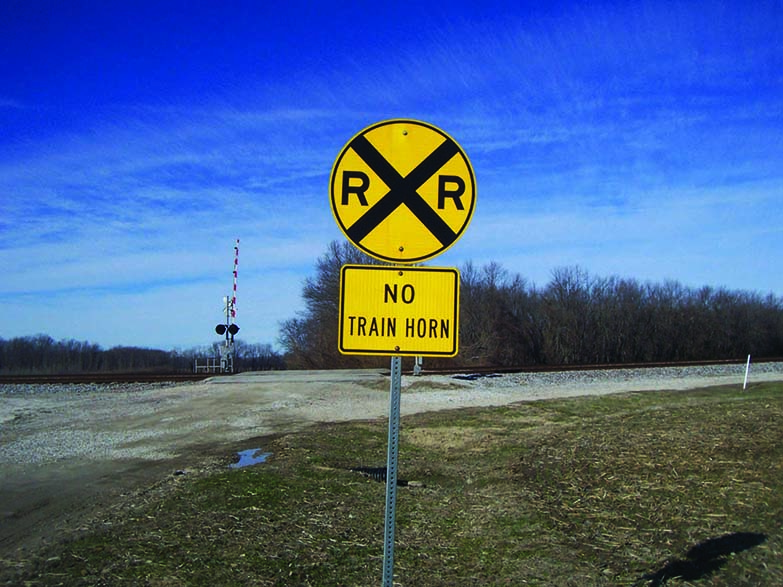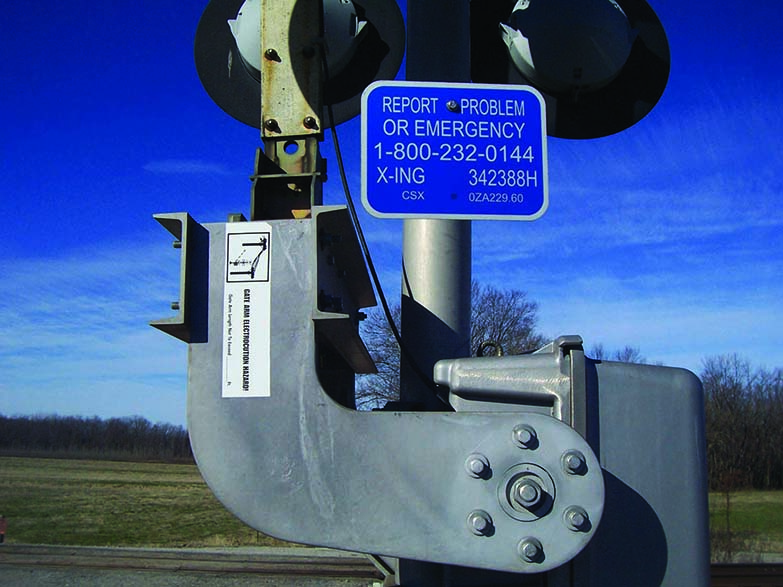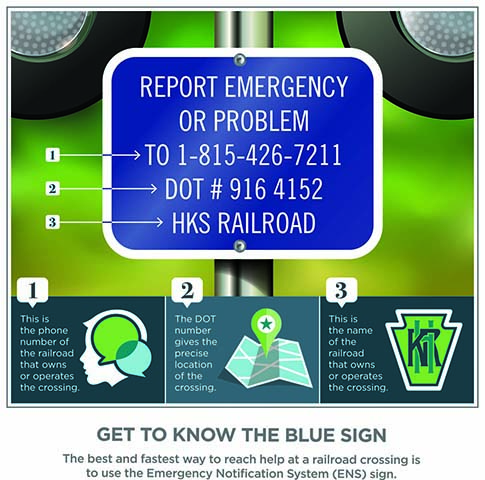Resources - Publications
Railroad Crossings Stop, Look, Stay Alive

CHANCING THE CROSSING……………………………………………………….4
TRAINS, TRACKS, AND PRIVATE PROPERTY………………………..8
RAILROAD SIGNS GIVE ADVANCED WARNING………………….. 14
ACTIONS YOU CONTROL AT RAIL CROSSINGS………………….. 18
VOICING CONCERNS ABOUT THE SAFETY
OF A CROSSING………………………………………………………………….. 24
CONCLUSION…………………………………………………………………………….. 26
ACKNOWLEDGEMENTS…………………………………………………………..28
DISCLAIMER……………………………………………………………………………….31
Fred Whitford
Director, Purdue Pesticide Programs
Chip Pew
Railroad Safety Specialist, Illinois Commerce Commission
Dennis Nowaskie
Superintendent, Southwest Purdue Agricultural Center
John Obermeyer
IPM Specialist, Purdue University
Kevin Leigh Smith
Continuing Lecturer and Communication Specialist, Purdue Agricultural Sciences Education and Communication
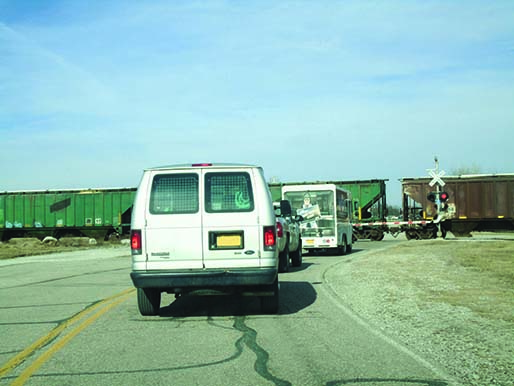
CHANCING THE CROSSING
There is a good reason why Indiana’s motto is Crossroads of America. Our state is home to more than 10,000 miles of federal, state, and county roads and 4,000 miles of railroad tracks. Trains use these 4,000 miles of track to move 332 million tons of freight across the state each year. All those roads intersect railroad tracks 6,600 times in Indiana.
Nationwide, there are more than 200,000 public railroad crossings, and more than 300 million vehicles cross them each day. Each day, most of us will drive across one or more railroad crossings. But when we cross those road-to-rail intersections we give little thought about what takes place where cars and trains share this piece of ground.
Crashes at rail crossings represent only a small percentage of the total number of highway accidents, and they seldom make the evening news or local newspapers.It might surprise many of you that someone in the United States is hit by a train every three hours. Those crash totals seem insignificant compared to other highway statistics, but each incident could have been prevented if the motorist or pedestrian would have used common sense and adhered to the signs and signals as they approached the highway-rail grade crossing and crossed the railroad tracks.
Have you ever been stopped in traffic waiting for an oncoming train to pass through the crossing when one or more drivers decided to ignore the warnings and tried to beat the train? The drivers probably thought, “Why do I need to wait? The train is way down the track.”
With the gates down, bells ringing, and signal lights flashing, to everyone’s amazement, the drivers passed the other stopped cars sitting in line, snaked around the lowered gates, and got to the other side of the crossing. Without so much as putting on the brakes, the drivers moved down the road, speeding to get to work. Just seconds after their vehicles made it through the crossing, the train streaked through the intersection with its horn screaming.
The drivers will never realize how close they came to not making it to work that day.
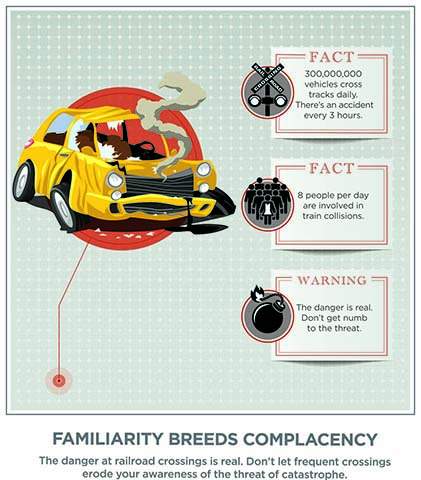
It’s easy to point fingers and shake your head in disbelief when other drivers take these risky actions in hopes of saving a few minutes. But how many times have you ignored the same warnings at railroad crossings? Have you ever not stopped before the tracks or rushed through a crossing as the gates were descending just because you didn’t have time to wait?
The simple fact is that we often forget that highway-rail grade railroad crossings are places where two modes of transportation intersect. At this road-to-rail intersection, lightweight, slow-moving vehicles are separated from heavy, fast-moving locomotives pulling loaded railcars. What’s separating them? Passive warning signs or active electronic warning devices. At the same time, people in cars are making the decisions.
Rail safety experts describe every intersection as a place where “A car of 1.5 tons of steel, plastic, rubber, and glass could meet up with a train of 6,000 tons of solid-built steel.”
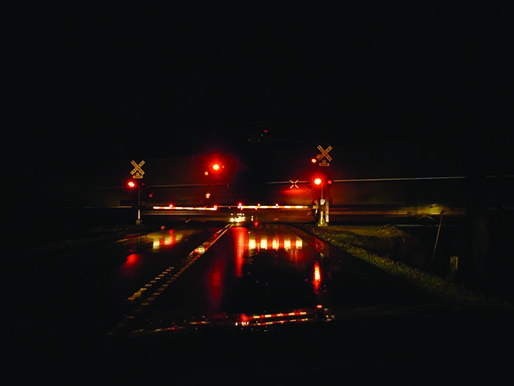
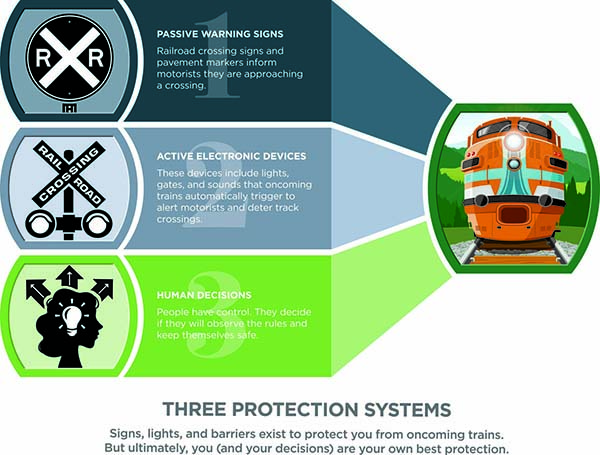
TRESPASSING ON RAILROAD PROPERTY
There has always been a mystique surrounding train tracks.
Some pedestrians think the area around the tracks is a personal park and playground. They walk on the steel rails and across bridges, take photographs of their children, watch birds and wildlife, walk the dog, and use them as shortcuts from one side to another. Some people are attracted to the tracks, because they feel they won’t be bothered by authorities.
What you may not know is that railroad track rights-of-way generally extend 25 feet from the center of the track on either side. Everything in the right-of-way is considered the railroad’s property.
You should not be there.

Any guess who wins that collision? Put all of your money on the train — that’s a guaranteed bet. Even if the event is a tie, the vehicle driver always loses.
This publication provides important information about the ways highway-rail grade crossings are marked and outlines precautions motorists should take when approaching highway-railroad grade crossings. We also describe strategies to use if you are ever stranded on a set of tracks. Our goal is to help the drivers of all vehicles (from cars to farm implements) better understand that trying to “beat” a train to save a few seconds can cost them their lives.


TRAINS, TRACKS, AND PRIVATE PROPERTY
Many people legitimately don’t know that railroad tracks are private property. Railroad companies own the rails and the land they are built on — either through purchase or by easement. This makes the railroad company responsible for maintaining their transportation system — tracks, ballasts, crossings, gates, and signs — according to regulations and best management practices.
Railroad officials and workers also must comply with U.S. Department of Transportation Federal Railroad Administration (FRA) regulations. The rules pertain to infrastructure, operations, and personnel. The FRA and their state partners continually monitor the railroads for compliance. In short, the railroad industry is highly regulated.
While railroad tracks are clearly private property, railroad crossings can be classified as private or public.
Private crossings are not maintained by taxpayers. For example, a crossing on a private road that leads directly to a farmer’s property or a privately owned residence is a private crossing.
Typically, crossings are considered public if they lead to things like businesses, schools, and places of worship.
Private crossings have only one requirement: Each one must post a blue Emergency Notification System (ENS) sign (see pages 21-23). FRA rules do not require private crossings to have advance warning signs or any other markings. Even so, some property owners may choose to install a crossbuck or a “Private Property” sign.
Meanwhile, federal regulations do not require train engineers to sound their whistles at private crossings; however, under unsafe situations (like imminent danger, limited visibility, or hazardous weather conditions) engineers may choose to do so. Landowners are supposed to maintain private crossings, but very rarely do. This can reduce the visibility of the tracks, which makes crossing them even more dangerous.
Public crossings are more numerous than private ones. The general public use these highway-rail grade crossings, so public tax dollars may be used to pay for maintenance and repairs to the road and approaches to the crossing.
Even so, railroads still have the responsibility to ensure crossing systems are functioning as designed and are providing the minimum warning time to acknowledge the presence of approaching trains. The signs and pavement markings before crossings are maintained by local, state, or federal highway authorities, depending on what type of road traverses a given set of tracks.
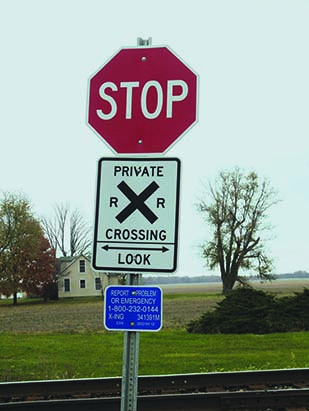
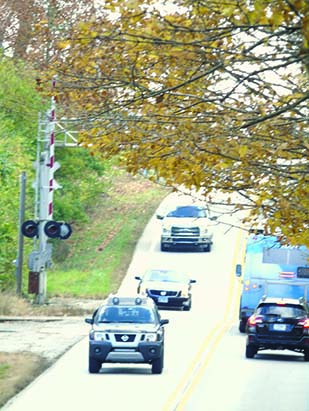
INTERSECTION DANGERS ARE REAL
It is common for motorists to encounter a 100-car, mile-long train being pulled by a series of locomotives moving at 60 miles per hour. Did you ever consider all that steel? You simply can’t compare trains to automobiles. Instead of having a gas pedal and a brake pedal, train engineers operate locomotives with a series of levers, throttles, brake levers, and horns. In reality, engineers operate trains rather than drive them.
For all intents and purposes, a train is like a big rollercoaster. Both only go where the tracks lead it. To stop a car traveling 60 mph it typically takes about 200 feet. Since it is heavier, a tractor-trailer requires about 300 feet. An average-size train with 100 cars typically requires up to 1 to 1.5 miles before it can come to a complete stop while the inertia of the train cars push on the locomotive.

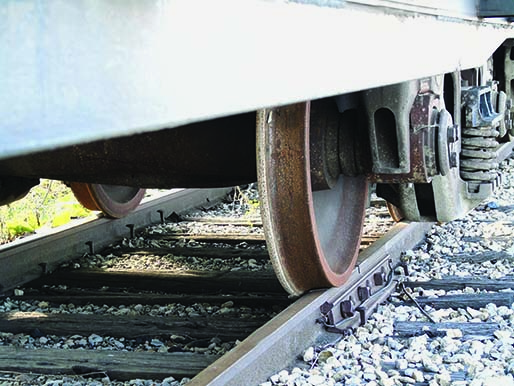
It’s important to note that a train’s wheels are smooth and they ride on smooth tracks with only a dime’s width of each wheel contacting the rail. You could compare this to trying to stop a car on a skating rink. The car will eventually stop, but it will take much longer.
Furthermore, trains can’t swerve. If train engineers see you on the tracks, there is nothing for them to do but crash into your vehicle as they attempt to stop. So, remember: Trains can stop, they just don’t stop quickly!
At public crossings, federal law requires engineers to sound their trains’ whistles unless a quiet zone has been established. Even then, engineers have the authority to sound whistles when conditions like imminent danger, presence of on-track workers, poor visibility, and even the presence of animals like livestock warrant.
Along the railroad tracks, the approaches to crossings have at least one whistle post (sometimes more) around 1,320 feet (or a quarter-mile) from each crossing. Whistle posts are visual reminders to engineers to start sounding their whistles, which is considered an operational warning. Train horns begin activating 15 to 20 seconds before the train enters a public crossing. They sound a sequence of two long blasts, one short blast, and another long one.
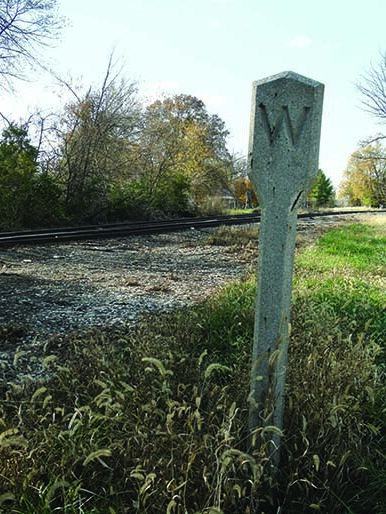

Here are two examples of quiet zone markings that inform engineers not to sound their trains’ whistles.
MORE THAN 30 PERCENT OF ALL TRAIN COLLISIONS WITH VEHICLES OCCUR BECAUSE MOTORISTS DRIVE AROUND LOWERED GATES.
When trains hit cars, trucks, trailers, or agricultural equipment, bad things usually happen not only to the motorists, but also to the railroads, their passengers, and local communities. Communities are endangered when collisions cause railcars carrying hazardous materials to derail. Although railroads fortify their tanker cars to comply with crashworthiness standards, those tankers can (and do) still puncture and rupture given the right circumstances.
Impatient drivers who are in a hurry and trying to beat trains put people, nearby water resources and environmentally sensitive areas, and cleanup crews in potentially dangerous situations. Responding to spills or releases caused by train collisions usually require specialized HAZMAT technicians and equipment that may be lacking in some communities.


EVENT DATA RECORDERS
Every train has an event data recorder, which is analogous to the black box devices found on commercial airlines. Event data recorders log and record all of a train’s operating functions. In case of a collision, all this data helps officials determine what took place before impact.
Most lead locomotives have outward facing cameras that record a train’s entire trip. Federal regulators are currently considering making cameras mandatory on all trains.
The video from these cameras could document a car going around a gate or not stopping at a stop sign at a crossing. Video would also show whether the gates and lights were working at the time of a collision.
Evidence from event data recorders and cameras could then be used to assign fault and used in court as evidence. More important, these devices could determine what caused any incidents.
What about the people in the vehicles that get hit by trains? If you are unfortunate enough to get hit by a train, the chances are high you will not walk away from the collision. The difference in weight and speed between the train and any other vehicle meeting it at an intersection, usually means that the trains will remain unscathed and the vehicles will be crushed and demolished.
While train engineers are not often physically hurt, they can be mentally traumatized, and suffer symptoms similar to post-traumatic stress disorder (or PTSD). Some engineers never fully recover from train-vehicle collisions that result in fatalities.
So why are there any incidents, crashes, or collisions to begin with?
One reason is that the driving public often miscalculates the speed and distance of oncoming trains. It’s similar to the illusion of watching a plane approach the tarmac. In reality, that slow-moving commercial jetliner is traveling in excess of 150 miles an hour. Like those jets, chances are good that trains are traveling much faster than what you perceive. Don’t be fooled by the apparent optical illusion.
In a typical year, there are 2,000 collisions, 800 injuries, and 270 fatalities in the United States associated with railroad crossings. Unfortunately, Indiana ranks near the top of these categories each year.
Statistics show that three out of four train-vehicle collisions occur within a 25-mile radius of the driver’s home. About half of all incidents actually occur within a 5-mile radius of a driver’s home. People begin to think trains operate on set schedules. But to be safe, people should expect a train on any track in any direction every time they cross the track.
IN A SPAN OF 15 MINUTES, THE SENIOR AUTHOR OF THIS
PUBLICATION RECORDED MORE THAN HALF OF THE TRAFFIC DID NOT COME TO A COMPLETE STOP BEFORE THEY PROCEEDED THROUGH THIS ACTIVE CROSSING.
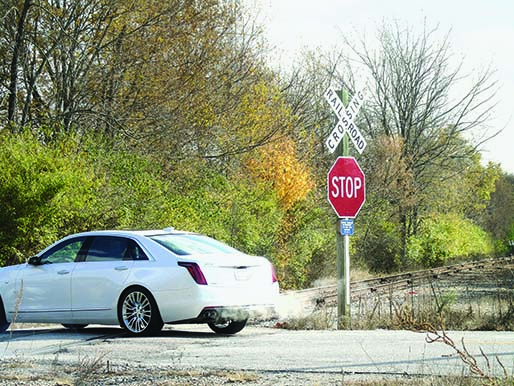
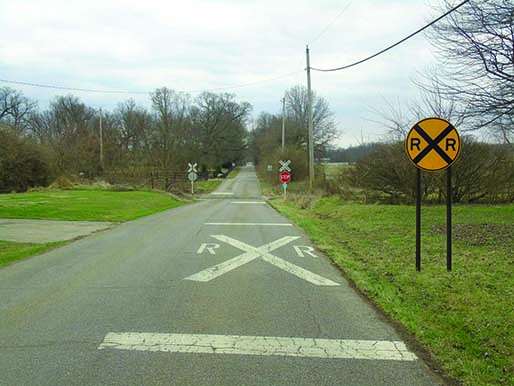
RAILROAD SIGNS GIVE ADVANCED WARNING
All railroad signs are consistently worded, their color scheme remains the same, and they are positioned so that drivers get the same messages approaching all rail crossings whether they are driving in North Carolina or California (and all points between). It is important to understand the meaning behind those signs and markings to prevent train-vehicle collisions at intersections.
PASSIVE MARKINGS
The signs and pavement markings associated with railroad crossings alert and inform motorists that they are approaching a rail crossing. At many intersections, static signs and road markings are the only things that indicate to drivers that there are tracks up ahead. These are called passive warning signals.
When it comes to passive railroad signs and markings, there are five major categories:
1. Informational or advisory signs
2. Advance warning signs
3. Advance pavement markings
4. Crossbucks with yield or stop signs
5. Road markings at the track
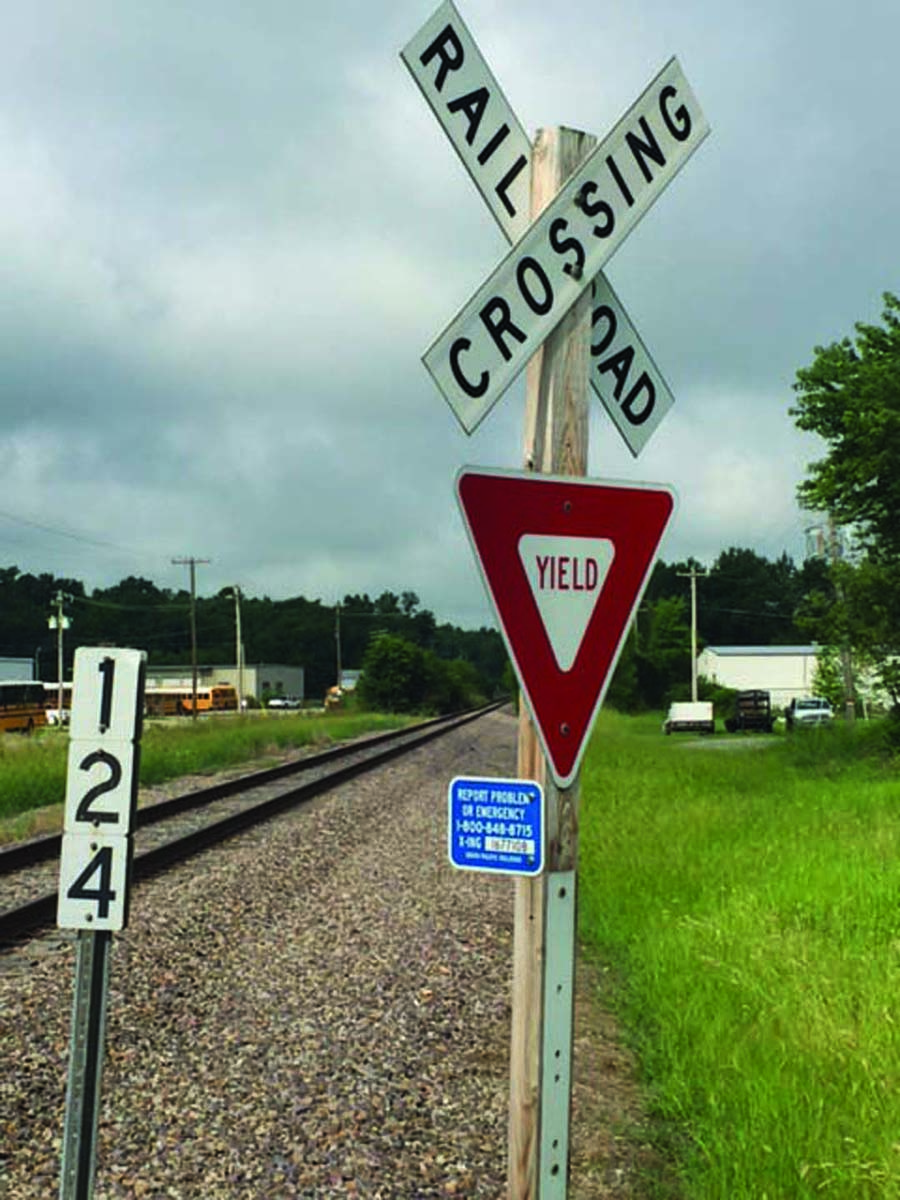
Informational or Advisory Signs
As the name suggests, these diamond-shaped signs let drivers know that a rail line is approaching or nearby.

Advance Warning Signs
Advance warning signs are round, yellow signs that have a large black X flanked by two large, black R’s. These signs tell drivers that a set of tracks is coming up within the next 750 feet.
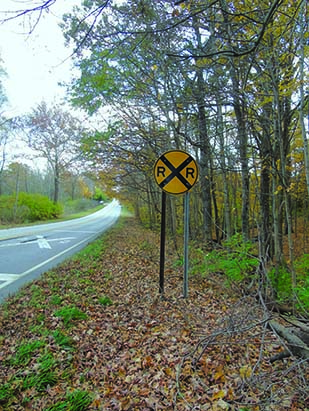
Advance Pavement Markings
Advance pavement markings are painted on the roadway between the crossing and the advance warning sign. Pavement markings are intended to remind and alert motorists that they will soon approach a railroad crossing.
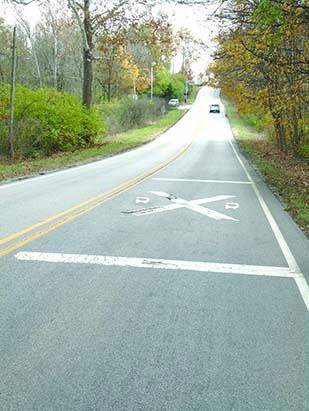
Crossbucks With Yield or Stop Signs
The black and white, X-shaped signs that say, “Railroad Crossing” are called crossbucks, and they are posted at every public crossing. They are regulatory signs that require motorists to yield to trains.
The problem is, many motorists do not know that crossbucks mean that they have to yield to the train. For that reason, all crossbucks at public passive crossings must be accompanied by either the highly recognizable highway yield sign or a stop sign. Crossbucks are placed parallel to the tracks on both roadway approaches. They are there to remind motorists that it’s the motorists’ responsibility to yield the right-of-way to oncoming trains.
When there is a stop sign at a crossing, remember that the stop sign takes precedence over the crossbuck. If there is a stop sign at a crossing, motorists must come to a complete stop before they can proceed across the tracks. Again, all public passive railroad crossings must have either a yield or stop sign below the two crossed boards.
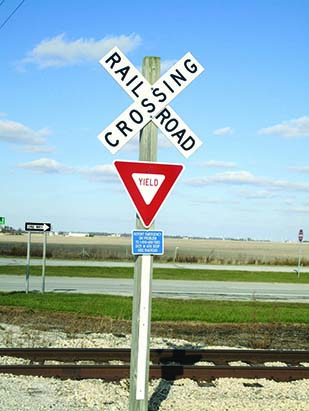
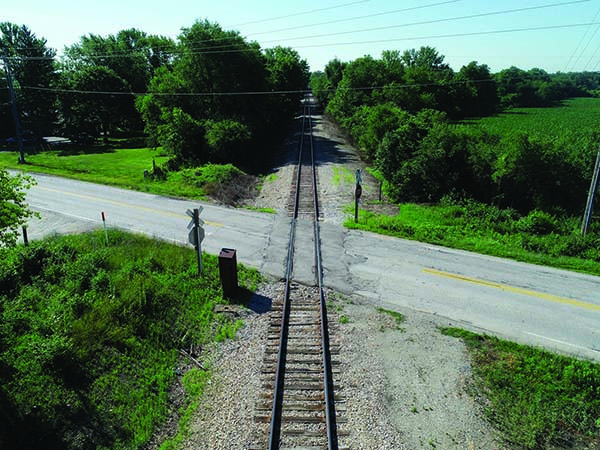
Road Markings at the Track
Painted on the road before many crossings is a thick white stop bar — it’s like the line you see at traffic lights and stop signs. Stop bar pavement markings guide motorists where to stop when there is a stop sign or gates block the lanes. Motorists should stop before the markings start, not on the markings.
ACTIVE WARNING DEVICES
Crossings with active warning devices are equipped with a combination of lights, bells, and gates. These devices are all automatically activated when the train hits a prescribed distance in advance of the crossing. That’s what makes them active warnings rather than the passive warnings described above.
When trains approach crossings, electronic charges are sent through the steel rails and activate the warning devices. Federal regulations prescribe that these electrical and mechanical devices must provide a minimum warning of 20 seconds before approaching trains enter a crossing. At crossings where traffic is higher, local authorities can increase the federal minimum warning time to 30 or 40 seconds to allow traffic to clear the crossing.
Let’s break down what happens during the 20-second warning time (or longer at some crossings) in more detail. Generally, it takes 4 to 6 seconds after the lights and bells activate for vehicles passing through the intersection to clear the crossing. It will then take 4 to 6 seconds for the gate to fully descend across the road. This means 8 to 12 seconds out of the total 20 seconds have been used. A crossing with longer than 20 seconds of warning time just experiences more time with the gates down.
Motorists who decide to drive around gates that are down have about 10 seconds to get from one side to the other. That’s if they decide to go right then. Usually, it takes motorists a few seconds to decide to make their move. So, in reality, the time left for them to make their way through the crossing may be as little as 5 seconds. It’s literally not enough time to drive around the gate and pass through the intersection before the train collides with them.
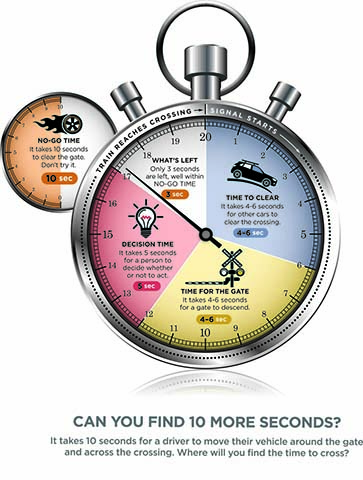
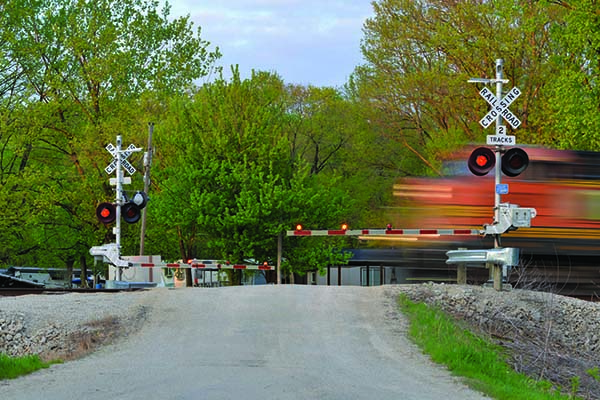

ACTIONS YOU CONTROL AT RAIL CROSSINGS
Transportation regulations (and, we hope, common sense) dictate that drivers have to yield the right-of-way to oncoming trains. The only way to travel safely across potentially dangerous intersections is for motorists to follow all signs, symbols, and signals. The warnings are there for your safety, and following their instructions might be just enough to save your life.
There are other things you can do to make rail crossings safer. Consider these actions drivers can take to prevent or reduce the likelihood of being broadsided by a train:
- Turn down the radio at every crossing.
- When you approach and pass through a crossing, give your full attention to looking in both directions down the tracks. Do your best to limit any distractions (such as talking on your phone or listening to music).
- Yield or stop according to the rules of the road. “Stop” does not mean “slow and go!” It means come to a complete stop.
- Do not stop any closer to the tracks than the stop bar painted on the pavement. This will protect you from the train’s 3-foot overhang from the tracks and any loads that might have shifted on the rail cars from striking your vehicle
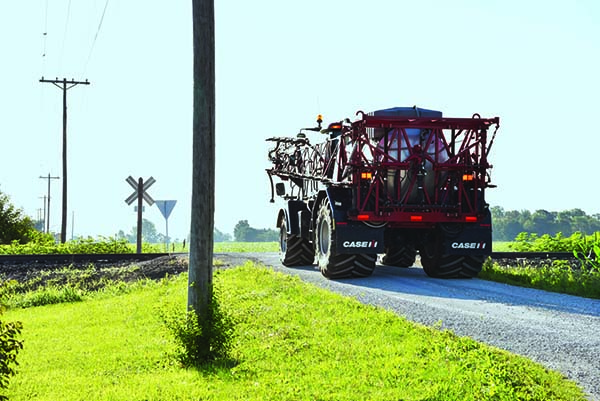
- Make sure there is enough room on the other side of the crossing for your vehicle. Do not cross the tracks if any part of your vehicle might remain within 3 feet of the tracks.
- Remember that school buses and vehicles carrying hazardous materials, by law, must stop no closer than 15 feet and no further than 50 feet from each set of tracks. Don’t be impatient and attempt to go around them at railroad crossings. Going around stopped vehicles at tracks isn’t just dangerous it’s also illegal.
- Don’t shift gears going over tracks. Shifting gears can increase the risk that you will stall the vehicle over them.
- If you hear the horn, assume the train is right around the corner even if you don’t see it (and stop!). If you hear a train’s horn, assume it will be at the crossing in 20 seconds or less. If you ignore the horn, your odds of crossing safely are too close to call.
- Never drive between lowered gates. Never drive around the warning gates unless law enforcement officers or railroad employees controlling that crossing indicate it is safe to do so.
- Wait to cross the tracks until the gates raise all the way up and the lights stop flashing. That’s the law. Motorists often start crossing the tracks as soon as the gates are high enough not to scratch the paint on their vehicles. But remember: Some intersections have two or more sets of tracks. Wait for the gates to rise completely and the lights turn off!
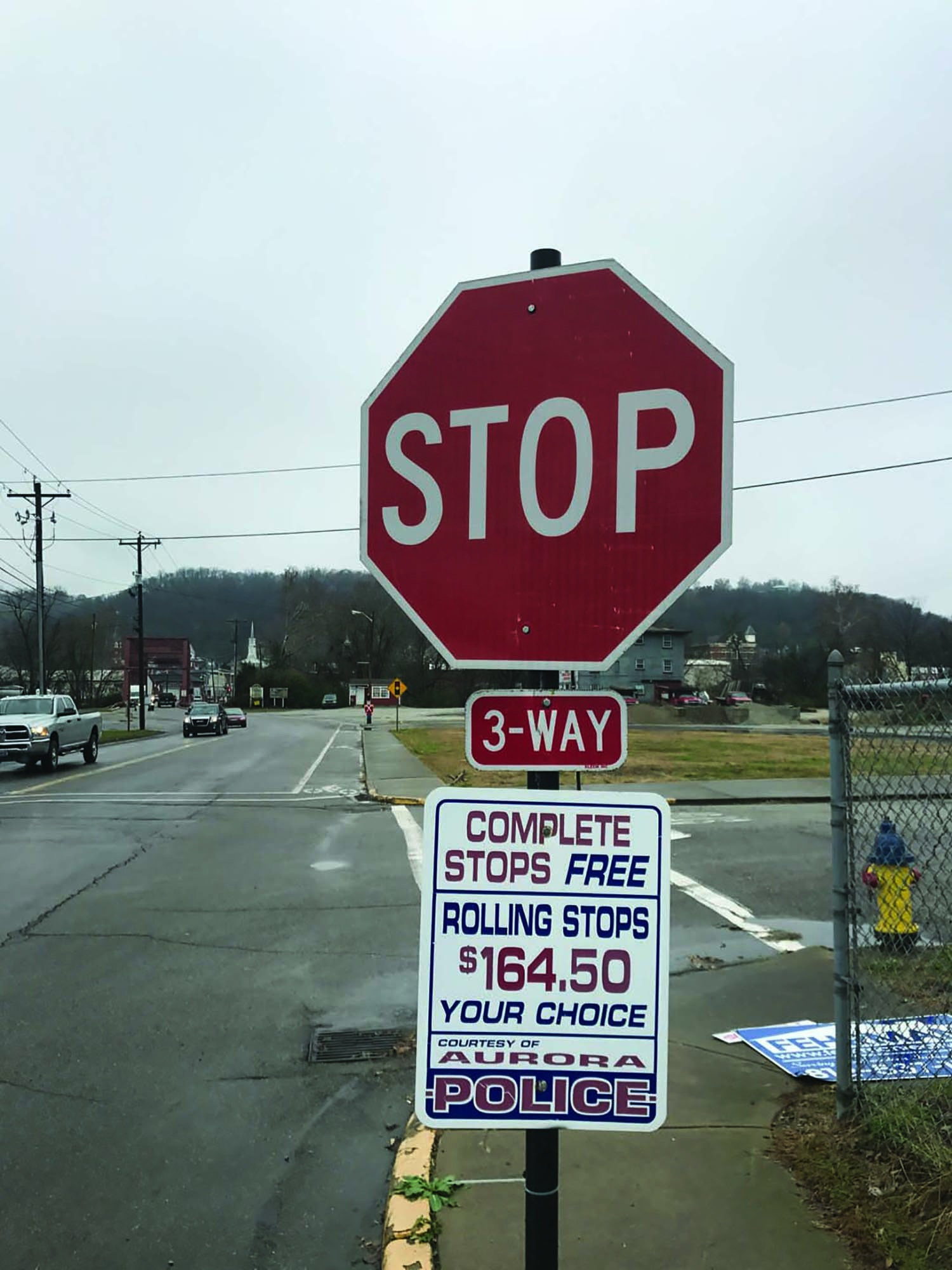
There are plenty of examples of someone assuming a crossing is clear, proceeding forward only to be hit by a train traveling in the opposite direction on the other track that is blocked from view by the first train.

BEWARE THE GHOST TRAIN
It might surprise you to know that half of all railroad collisions occur at crossings with warning devices. People ignore the warnings.
Often, people ignore the signals when a crossing has more than one set of tracks, and there a train is blocking part of the crossing. Motorists assume the first train caused the guard arms to come down, so they drive around the lowered gates only to be hit by another train going in the opposite direction on the second set of tracks.
This has come to be called the ghost train scenario.
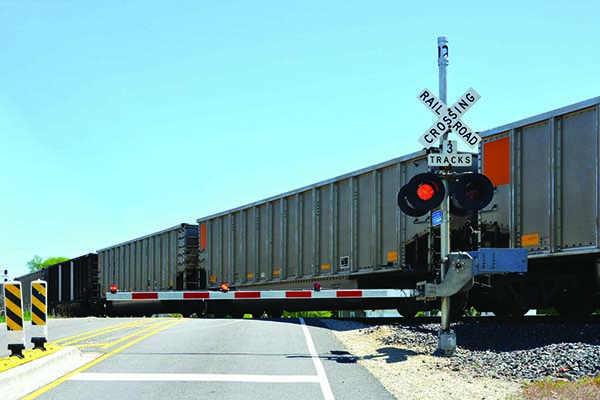
- Always look in both directions before crossing the tracks. Make sure it is something you remember to always do, not just say.
- Know how long it takes to cross a set of tracks. An 80,000-pound semi-tractor and trailer or agricultural implement can take 14 to 20 seconds to cross a single set of tracks.
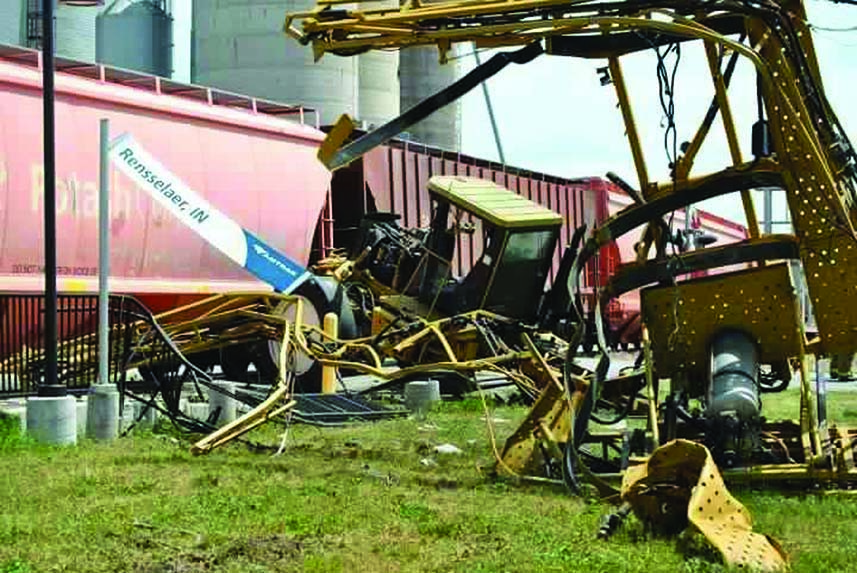
I JUST SAW A GHOST
Here is one person’s account of his frightening encounter with a ghost train.
“Several years ago, I was winding up a two-day business trip and had my young son along with me in my car.
“My last stop just after lunch was at a fertilizer branch. It is located alongside a railroad track for shipping grain out and bringing product in.
“My son and I turned off the state highway onto the county road that runs just east of the business. A double set of railroad tracks with warning lights and crossing gates is located on the county road near the state highway.
“As we approached, the arms were down, the lights were flashing, and a train passed, heading east. Once the train passed, I put the car in gear, assuming the lights would stop flashing and the gates would go up.
“They didn’t stop or go up. I waited what seemed like several minutes — it was maybe a minute. I was already late (as usual) for my next appointment. Figuring the signals were stuck, I moved forward, preparing to angle my small car through the gates.
“Just then, my son, screamed, ‘Daddy, stop! There’s a train.’”
“I immediately looked back to the east. Sure enough, a train was headed toward us on the other track, headed west. His horn began to sound. Heart in my throat, I backed off the track on the road as the train passed.
“I gave my son a hug. Praise God he was with me!”

STUCK ON THE TRACKS
There are many reasons why vehicles can get stuck on the tracks: The vehicles run out of gas; trailers bottom out; flat tires; batteries die; drive shafts break; or gates come down on top of vehicles. In some instances, it’s possible to even get stuck within the two gates if the cars in front of you or in back of you can’t (or won’t) move.
What you should do if you are ever stranded on a crossing depends on whether you hear or see a train coming down the tracks.
STUCK ON THE TRACK AND NO TRAIN IN SIGHT?
If your vehicle is stuck on railroad tracks and you don’t see or hear a train, do not waste time trying to push the vehicle off‹ the tracks. Remember it could take a 1 mile or more for a train to stop.
Get out of the vehicle as soon as possible and look for a blue rectangular sign known as the Emergency Notification System (ENS). ENS signs must be placed in conspicuous locations at crossings on signal appliances or posts. The signs can face oncoming traffic on both approaches parallel to the crossing, or they can be perpendicular to the tracks, which make the signs easy to see from stalled vehicles.
ENS signs include a toll-free number that connects to the railroad company that operates or owns the crossing. The signs also include and a six-digit number followed by a letter, which is known as the DOT number.
DO NOT CALL 911 FIRST
We have all become conditioned to call 911 in an emergency.
That’s normally a good impulse, but when it comes to train safety, your first call should be to the number listed on the Emergency Notification System (ENS) sign. That is the blue sign at every crossing.
By calling the railroad directly, you will save a lot of time as the operator can contact their trains quickly. If you call 911, you are hoping the 911 operator will figure out which railroad crossing you are located at and what the DOT number is for that crossing.
While the 911 operator tries to determine exactly where you are, the train is still approaching the crossing. The minutes you save by calling the railroad directly might be the time the train needs to stop.
Every railroad crossing (public and private) has its own unique DOT number. When you provide a railroad employee answering the phone the DOT number on the ENS sign, the employee will know the exact location of the crossing you are stranded on. Some larger railroads connect you to someone who can help you after a prompt identifies that you want to report a vehicle stopped on the tracks.
When you use the ENS sign to call the railroad, the employee will search a computer database using the DOT crossing number to get its GPS coordinates and convert the location to a map of the operating area. This allows the employee to contact any trains in close proximity to the crossing, and to warn them that there is a stalled vehicle on the tracks. Engineers can then begin the process of stopping their trains before striking any stranded car, truck, or farm implement.
Your second call should be to 911 to tell authorities that your vehicle is stuck on the tracks and that you informed the railroad of the situation. The 911 operator can dispatch police and a tow truck to provide further assistance. As a courtesy to the railroad, call them back to let them know when your vehicle has been removed from the tracks.
You can also call the number on the ENS sign to report visibility restrictions due to overgrown brush, debris on the tracks, and even rough crossings in which the asphalt or timbers in the crossing are crumbling or splintering.
STUCK ON THE TRACKS AND A TRAIN IS COMING?
If you are unlucky enough to be stuck on the tracks when a train is coming, there isn’t enough time to do anything else but save yourself, other passengers, and pets. Never make the mistake of wasting valuable seconds by trying to save or retrieve personal items.
Exit the vehicle, then run back toward the oncoming train, but away from the tracks at a 45-degree, or pie-shaped, angle. If you run in the same direction the train is traveling (that is, if you run away from it), you risk being injured by flying debris as the train hits, smashes, and moves the vehicle down the track. You may think running toward a train is like running toward a burning building, but it may save your life.

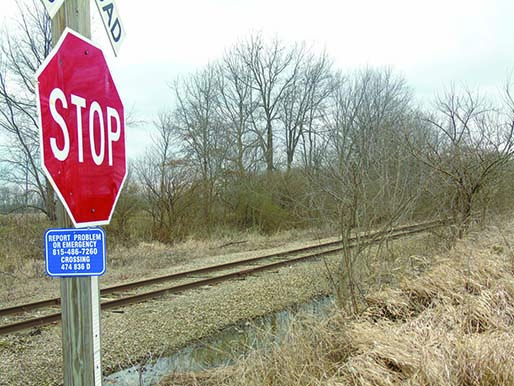
VOICING CONCERNS ABOUT THE SAFETY OF A CROSSING
There are a number of situations when it is a good idea to notify railroad operators of unsafe crossings.
With so many crossings, there may be times when visibility is poor. Tall weeds or trees may obstruct a driver’s view looking in one or both directions.
Also, there are circumstances when the electrical and mechanical devices at a crossing malfunction. You might see warning devices activate — lights are flashing, bells are ringing, and the gates are down. However, as you get close to the gate, you see there’s not a train approaching from either direction. If these false activations happen routinely, drivers might start to feel that driving around a gate is warranted.
Conversely, the electrical and mechanical devices may fail to activate when trains approach. Devices that fail to activate are far more serious — the crossing system provides no indication a train is approaching, which means no lights, no bells, and no descending gate. Fortunately, these situations are rare. Still, they do occur, which should reinforce the need to always look and listen for trains in both directions when you approach any railroad crossing.
You can call the number on the ENS sign to report any of these safety concerns directly to the railroad. In the event you find such a crossing, you should also contact your state’s department of transportation — in Indiana call the Indiana Department of Transportation Services at 317-232-1491. Be prepared to give your name and the DOT number from the blue sign at the crossing.
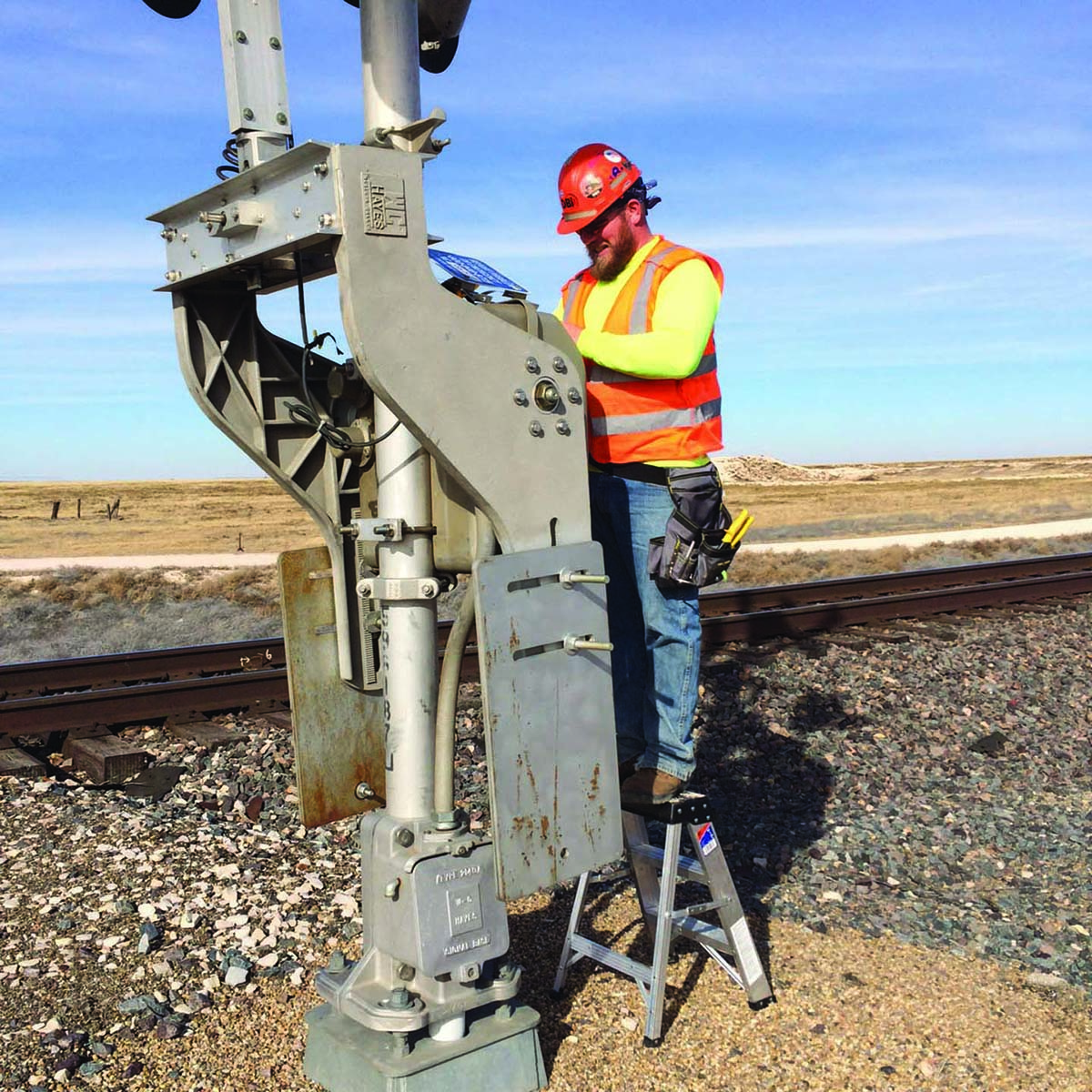

CONCLUSION
Many of us cross railroad tracks countless times without ever having a close call with an approaching train. That’s your good fortune, because there are people who are not so lucky. Trying to beat a train to save time could be the “end of the line” for the motorist who makes such risky choices.
By exercising good judgment and actively looking out for trains, you have the ability to stop so trains won’t hit you at crossings. Remember: Engineers of oncoming trains may not have the option to stop in time. Only you do! No incidents occur at railroad crossings when motorists do not put their vehicles in positions to be struck by trains.
Take the safe course. Appreciate the fact that the signs, markings, and devices are there to protect you. Read and Heed. Approach the tracks with caution, listen for the train’s horn, look both ways, and make sure you can clear the tracks safely.
Ultimately, the choice to follow those instructions is yours. If you guess wrong, you probably will not get another chance. Crossing in front of an oncoming train to save a few seconds isn’t worth the potential consequences — including losing your life.


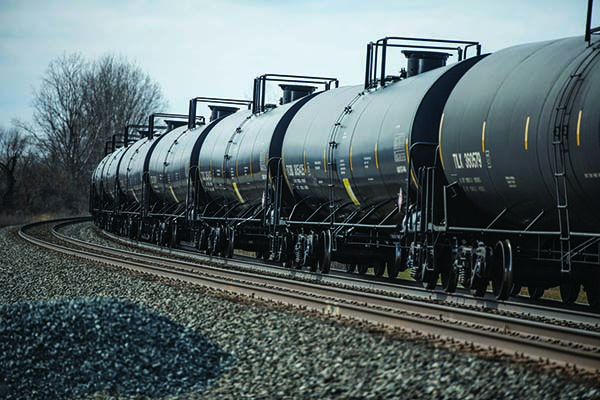
ACKNOWLEDGEMENTS
Thanks to Dawn Minns for graphic design. Thanks also to the following individuals who provided valuable comments and suggestions that improved this publication.
TOM BECHMAN, INDIANA PRAIRIE FARMER
JASON BELTZ, AVP-RAILROAD DIVISION
JERRY BOGER, PREMIER COMPANIES
ROGER DUMOND, KOVA FERTILIZER
JACK HUDDLESTON, CANADIAN NATIONAL RAILWAY (RETIRED ENGINEER)
WAYNE HUG, INFRASTRUCTURE MAINTENANCE CONSULTANT
TOM MANLOVE, CERES SOLUTIONS COOPERATIVE
DENNIS MOGAN, ILLINOIS COMMERCE COMMISSION

DISCLAIMER
This publication is intended for educational purposes only. The authors’ views have not been approved by any government agency, business, or individual and cannot be construed as representing a perspective other than that of the authors. The publication is distributed with the understanding that the authors are not rendering legal or other professional advice to the reader, and that the information contained herein should not be regarded or relied upon as a substitute for professional consultation. The use of information contained herein constitutes an agreement to hold the authors, companies or reviewers harmless for liability, damage, or expense incurred as a result of reference to or reliance upon the information provided. Mention of a proprietary product or service does not constitute an endorsement by the authors or their employers. Descriptions of specific situations are included only as hypothetical case studies to assist readers, and they are not intended to represent any actual person, business entity, or situation. Reference in this publication to any specific commercial product, process, or service, or the use of any trade, firm, or corporation name is for general informational purposes only and does not constitute an endorsement, recommendation, or certification of any kind by Purdue University. Individuals using such products assume responsibility that the product is used in a way intended by the manufacturer and misuse is neither endorsed nor condoned by the authors nor the manufacturer.

Reference in this publication to any specific commercial product, process, or service, or the use of any trade, firm, or corporation name is for general informational purposes only and does not constitute an endorsement, recommendation, or certification of any kind by Purdue Extension. Individuals using such products assume responsibility for their use in accordance with current directions of the manufacturer.
Find out more at THE EDUCATION STORE edustore.purdue.edu
July 2020


